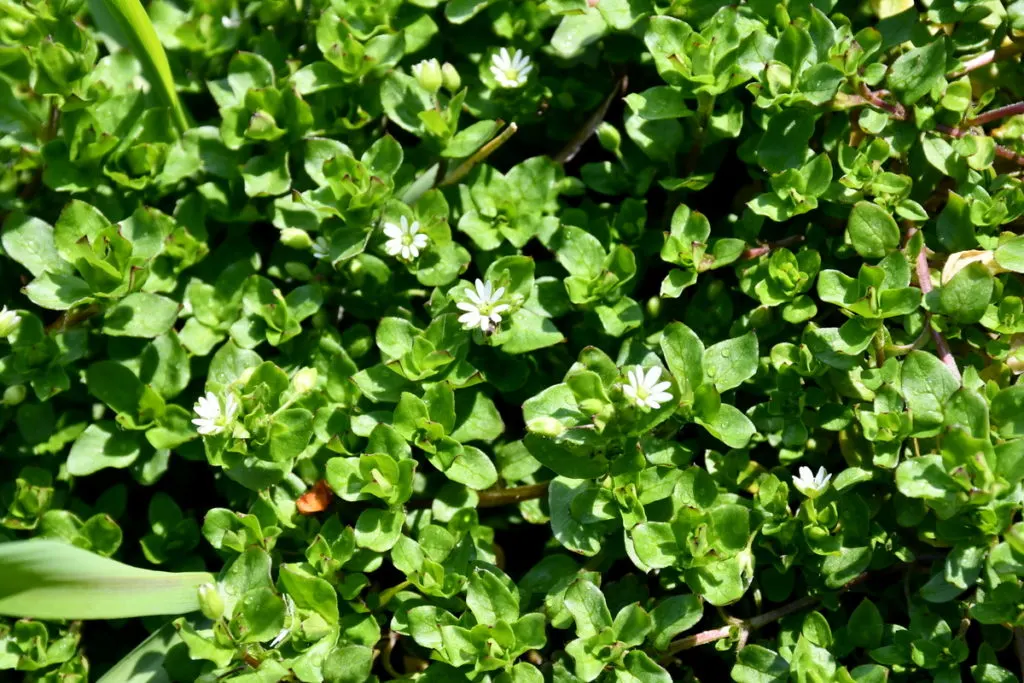
Stellaria media is all around us, one of the numerous early wild edibles, more commonly known as chickweed.
Other names for this gracious little plant include chickenwort, starweed, maruns, craches and winterweed.
Look casually down at the edge of a path or hedgerow in early spring or late fall and your eyes are destined to fall upon it.
Chickweed is the star of the ground, both literally and figuratively.
Take a closer look at the flowers:
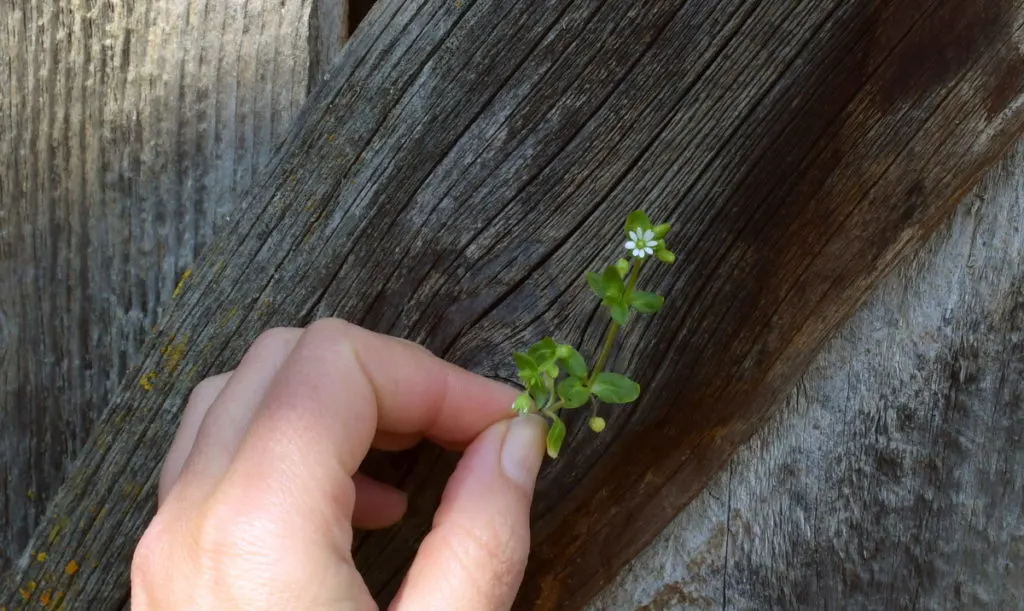
It appears that they resemble a star. Naturally, this statement is a matter of opinion.
If you are searching deeper into word origins, stellaria is derived from “stellar”. Quite literally, this means “like a star”.
Media is also derived from Latin, which quite simply means “middle”, “middle ground” or intermediate”.
Chickweed is also considered a star because of what wonders it does for the body. We’ll get to those stellar health benefits in a moment.
Identifying chickweed in the wild
Chances are good that you have already come across chickweed while out on a short walk.
But maybe, you’ve never given it much thought as to whether it was edible, or not. By now, you’ll have already come to the realization that it is totally edible, at least the above ground parts – otherwise this article would be very short indeed.
Chickweed is an annual that is native to Eurasia. By now, it has spread throughout the world by the production of tiny pebble-like seeds and sprawling roots. Its fragile strength and determination to grow just about anywhere, is nothing short of incredible.
Identifying by flowers
One of the first things you will notice about chickweed is the flowers.
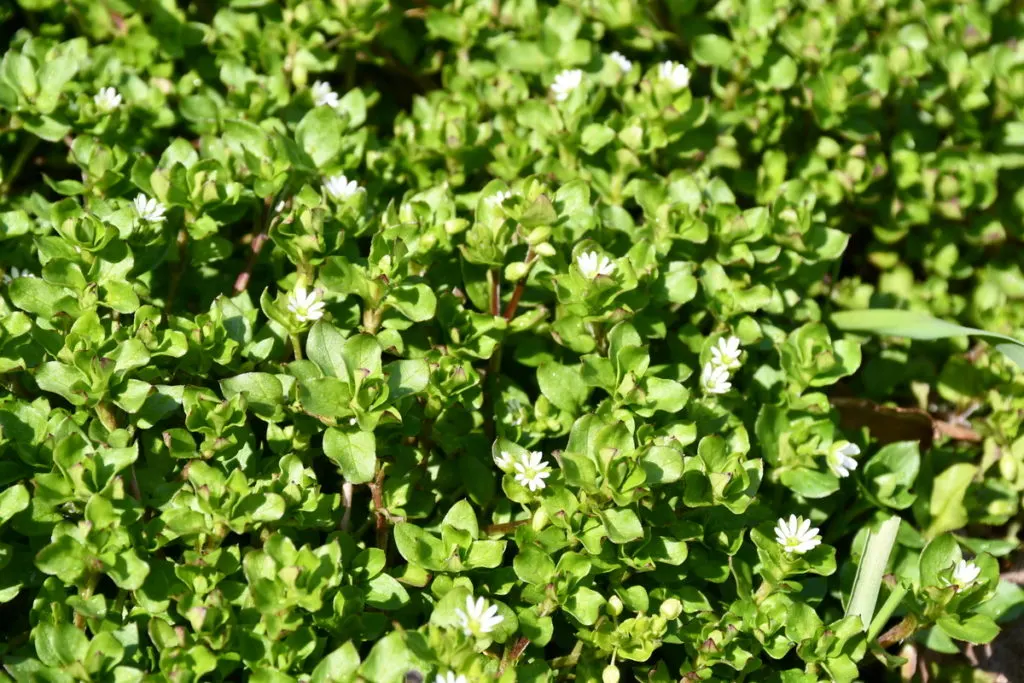
Ready and waiting to be snatched up by chickens and human foragers alike.
There are 5 tiny white petals, with such deep clefts that a novice forager may mistake for 10 individual petals. Below these delicate petals are 5 green sepals (outer parts of a flower that enclose a developing bud) which are characteristically covered with very fine hairs.
Yes, the chickweed flowers are edible, so is the stem.
A closer look at the chickweed stem
Pluck a single stem of the plant and bring it close enough to your eyes to see the details.
Notice that is has a single line of hairs, equivalent to a plant mohawk, running along the length of each stem. This is perhaps the defining feature of Stellaria media.
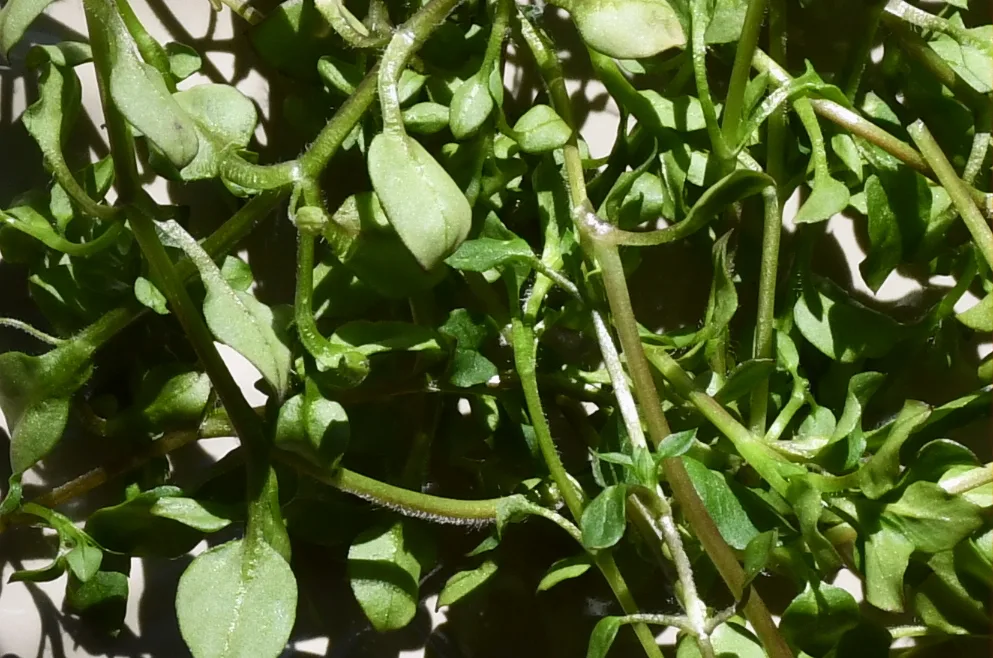
It helps to distinguish common chickweed from mouse-ear chickweed (Cerastium fontanum), which is similar, yet not quite the same. Mouse-ear chickweed is also edible, but perhaps less appetizing as it has fine hairs all along the stems and leaves.
You can also recognize chickweed by its growth habit: low to the ground and sprawling. If it receives plenty of moisture and shade, it can get quite leggy. For fresh eating, be sure to only clip the tops of the plant, as the stems can get stringy/woody quite quickly.
Is it possible to mistake chickweed with anything else?
Besides possibly mistaking chickweed with mouse-ear chickweed, you’ll also want to know how to identify scarlet pimpernel (Anagallis arvensis).
When foraging for chickweed, the white flower is always a good indicator. But what if the flower is not yet present? That is where novice foragers can run into some trouble.
Then you have to search for other clues. In the case of scarlet pimpernel, you will immediately notice a square stem. Look closer and notice that the leaves are dotted-black underneath.
Another indicator that chickweed and pimpernel are not the same plant, is that pimpernel flowers from June to September during the hottest summer months. While some sources state that the leaves are edible, it is a weed that is best to avoid. Watch the animals and they will do the same.
Identify chickweed correctly and you will be in for a treat. The other one is definitely not a treat.
Some species of spurge (Euphorbia) also look somewhat like chickweed, though they will show a milky sap when the stem is broken. Even skin contact with the sap can leave you with rashes. It is best to avoid touching this group of plants (with bare hands) altogether.
Short and sweet foraging tips
You’ll most often find chickweed growing where it is cool, moist and shady. But not always. It needs enough shade to thrive and some patchy sun to open the tiny flowers.
Even more than that, you’ll find it growing in patches, rather than single specimens. Once your eyes are attuned to seeking it out, you’ll be able to find it by color alone. The shade of green will stand out among the other newly emerging foliage.
Try searching for chickweed in early spring, never in the heat of summer – unless it appears by the side of your well-watered shady garden.
It is also useful to know about foraging for chickweed:
Chickweed does not have milky sap.
Harvest the top 2-3″ of chickweed with scissors, only as much as you need at once. Stems closer to the ground tend to get stringy and less palatable.
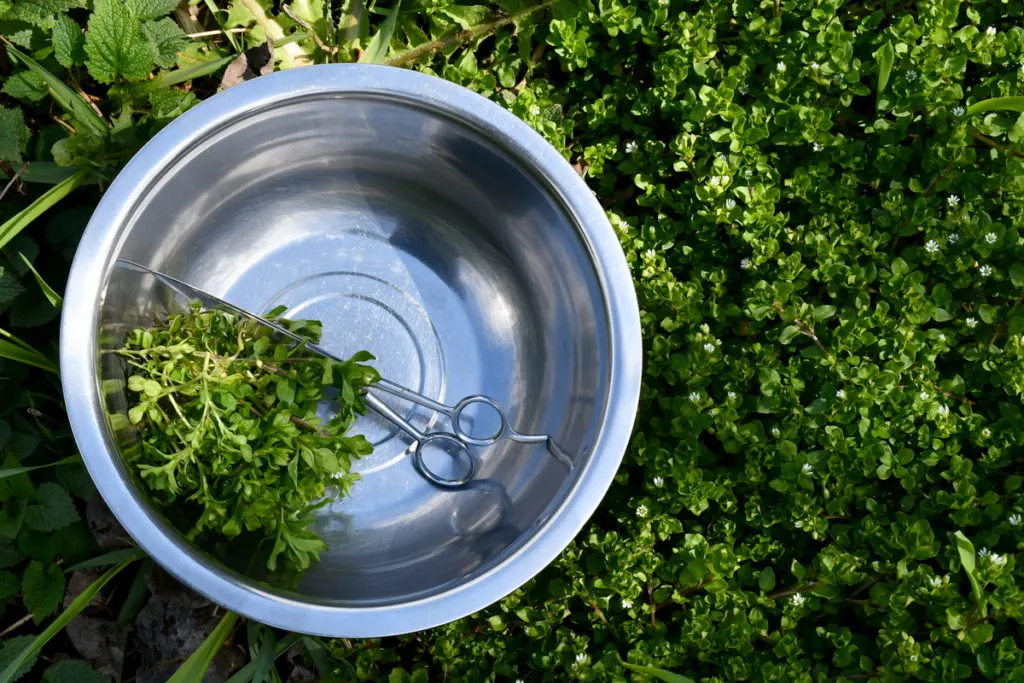
Be sure that you do not have any stray weeds in your handful of chickweed.
With those quick harvesting tips in the back of your mind, you are on to the next step – finding out how you can benefit from this amazing herb.
More about chickweed and what it does for your body
Not only does chickweed contain numerous essential vitamins and minerals, it also contains special plant compounds that lend to its healing nature:
- phytoserols
- tocopherols
- triterpene saponins
- flavonoids
When dealing with many herbal remedies, we are faced with a lot of “maybes“.
Maybe chickweed helps with weight loss, maybe it reduces inflammation, maybe it fights germs…
Looking beyond science, know that even the ancient Greeks wrote about chickweed. The rest is history, so they say – animals and people have been eating it ever since – and well before.
Ask any herbalist and they will tell you that chickweed is a wonderful herb that supports the liver and the whole lymphatic system.
It helps to remove excess fats from the body – you’ll want to drink a chickweed infusion for this. Chickweed also soothes and moisturizes tissues in the body. For this healing aspect, poultices are absolutely wonderful.
As a spring tonic that is nutritive, diuretic, vulnerary, tonic and demulcent, chickweed is one plant you won’t want to miss.
Unless…
In rare occasions, chickweed can cause allergic skin reactions. As with sampling new-to-you herbs, always test it first in a small amount before digging deep into that bowl of chickweed pesto.
Because chickweed contains saponins, it should be consumed in moderation, otherwise it may cause a stomach ache or diarrhea.
Chickweed is best avoided when pregnant or breastfeeding.
Nutrients in chickweed
If you find a patch of luscious chickweed in your backyard, consider yourself lucky. For you are about to boost your immune system with every green bite.
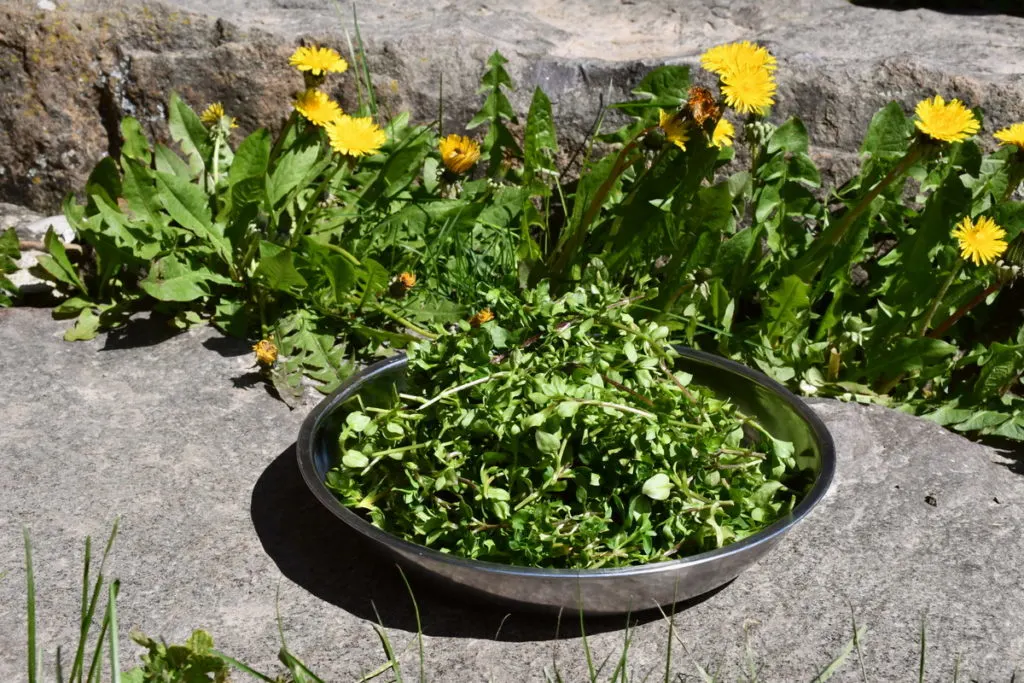
Chickweed contains several vitamins and minerals:
- vitamin A
- vitamin C
- B vitamins: folic acid, riboflavin, niacin and thiamine
- calcium
- magnesium
- manganese
- zinc
- iron
- phosphorus
- potassium
All those beneficial nutrients are free for the taking in a small handful of wild greens. You don’t even need to plant or tend to them, they grow all on their own.
Check out even more amazing uses for this wild edible here.
Uses for chickweed
You’ve found it, harvested it, admired it, now what are you going to do with it?
There are several ways to utilize an abundance of chickweed, most of them require using the plant in fresh, not dried, form.
Make sure you get to them first – before your backyard chickens do.
Chickweed infusion
Making a chickweed infusion is the easiest way to make a healing concoction.
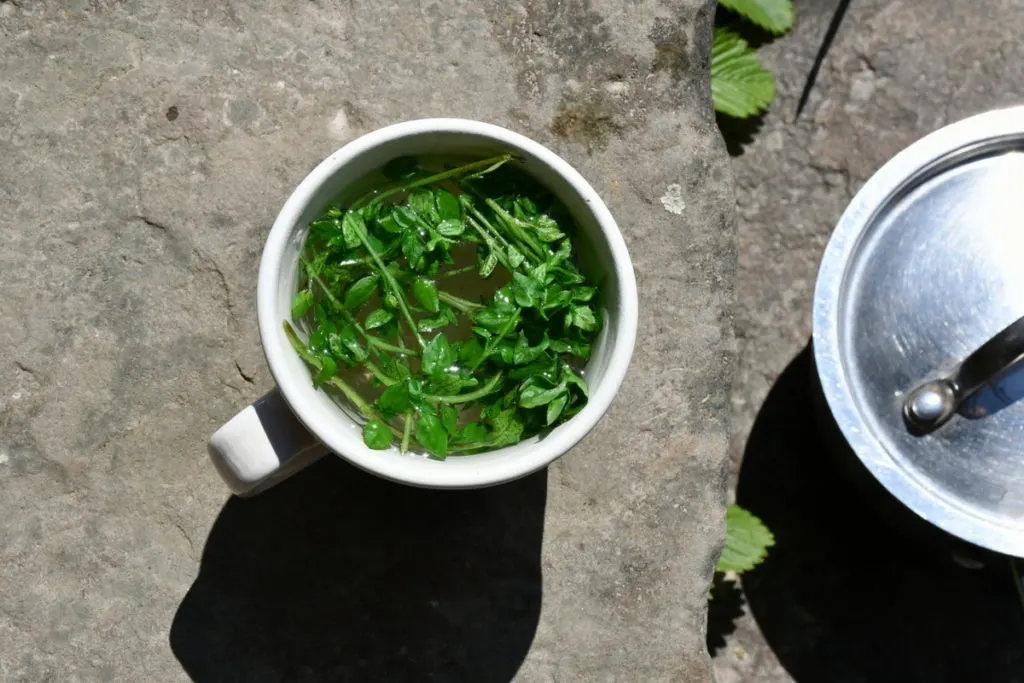
There is no recognized standard dosage for consuming chickweed, many experts stick to one, maximum two, handfuls of fresh chickweed per day.
In the case of making an infusion, wilt the chickweed greens for one or two days, then measure out one heaping tablespoon per each cup of hot water.
Pour hot, not boiling, water over the wilted chickweed, allowing it to steep for about 10-15 minutes.
Adults may drink 2-3 cups a day.
As with consuming any herbs, use your intuition and ask your body what it needs. Perhaps you need to drink it everyday for two weeks to feel the benefits. For others it may be best to take a week off here and there. Listen to what feels right for your body.
Chickweed poultice
Poultices are great to know-how-to-make when you are working, playing, or even just relaxing outside.
If you get stung when you are out in the garden, time is of the essence. With a patch of chickweed nearby, all you have to do is run over, pick a few stems, shake them off and chew them into a green mass.
Take this green healing goo and apply it generously to your bite/sting.
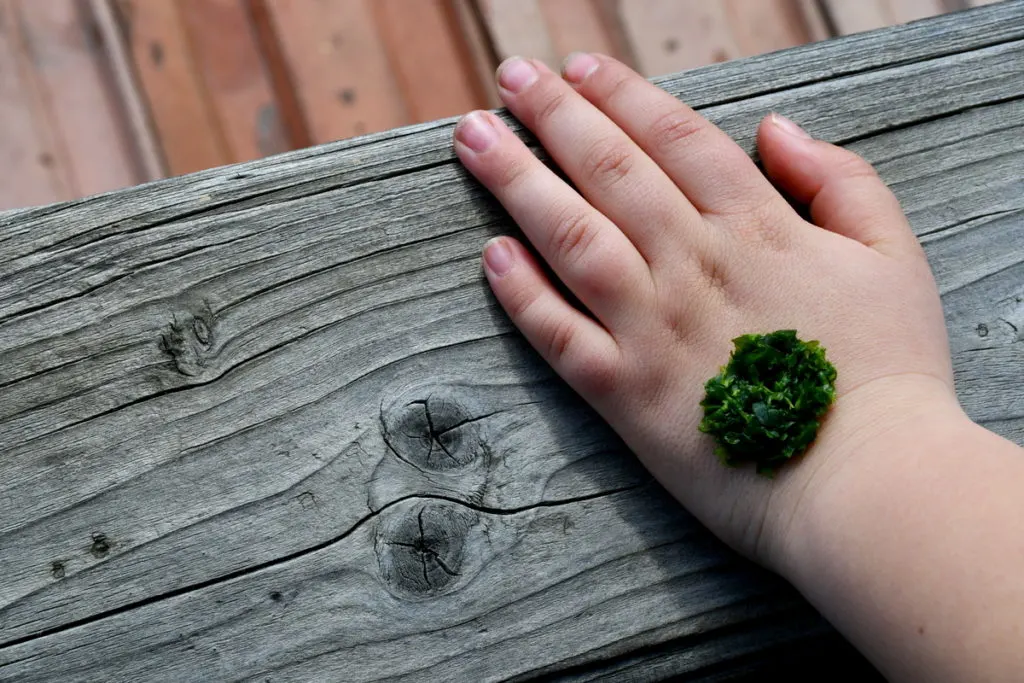
Know your natural poultices so you can get relief when you are out and about.
If your situation isn’t so serious, say you have a rash you wish to heal, go ahead and take 2 cups of chickweed inside. Macerate it in a mortar and pestle, then add 1-2 tablespoons of aloe vera gel.
In the middle of summer you may not find any chickweed to make a poultice from. It is plantain to the rescue! Plantain can be used for wounds, bites, rashes and more.
Chickweed tincture
To make a chickweed tincture you’ll only need two ingredients: fresh chickweed and alcohol. Brandy, vodka, 100 proof alcohol, whatever it is that you prefer making your homemade tinctures with. Always go for a good quality drink though, since you will be consuming it via the mouth.
For it to taste good in the end, it needs to taste good in the beginning.
Pack a mason jar (or any jar you wish to reuse) 2/3 full of fresh chickweed, then add enough alcohol to cover it. But, be sure to leave about 1″ headspace. Cover and store in a dark place for a month.
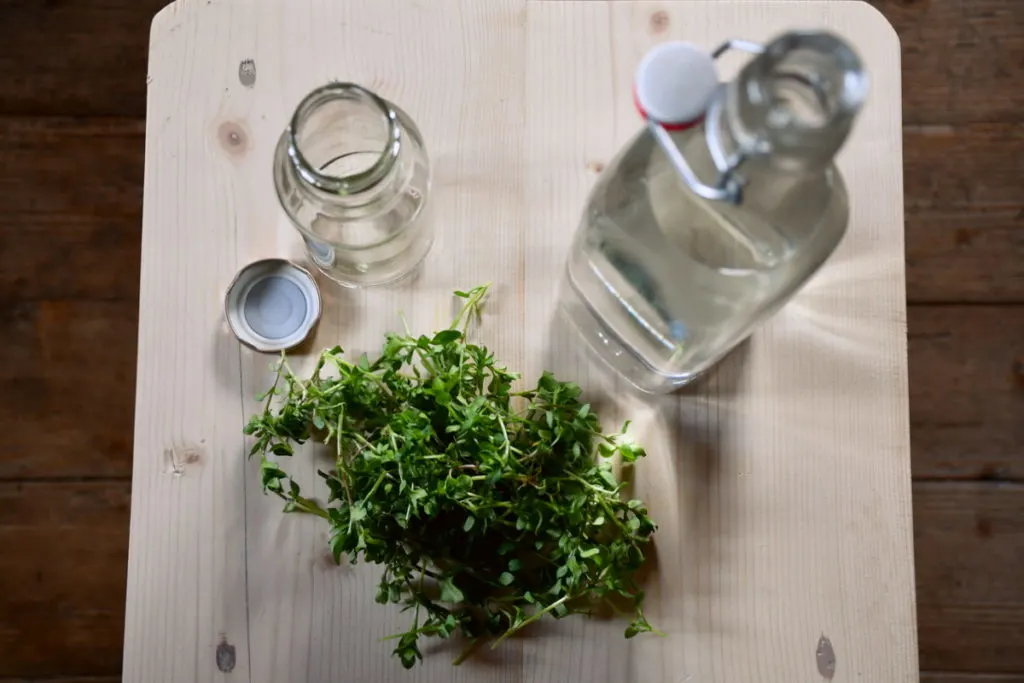
If using dried chickweed, fill the jar half full.
When you remember your hidden tincture, give it a little shake, or stir. When the month, or 6 weeks, is up, strain the chickweed and pour the tincture in dark bottles.
Use your chickweed tincture as needed.
Taken internally, studies show that chickweed can reduce inflammation and inhibit histamine reactions. New theories suggest that many modern diseases stem from inflammatory conditions, and at the same time allergies are on the rise. Chickweed tincture combats both these issues when taken daily.
Ashley from Practical Self Reliance
Chickweed Spring Vinegar
Making your own herbal vinegars may be going out of fashion. But, for those of us who prefer salads without French, thousand island, or Caesar dressing, it is the thing that keeps us going – and excited about salads – all winter long.
Nothing compares to the nutrients added to your salads via an herbal vinegar.
To make your own chickweed spring vinegar which extracts all the beneficial nutrients from the plant, you’ll need:
- 2 handfuls of fresh chickweed
- 3 cups of organic apple cider vinegar
- 2 tablespoons blackstrap molasses, optional
Chop the spring greens up finely and transfer them to a glass jar.
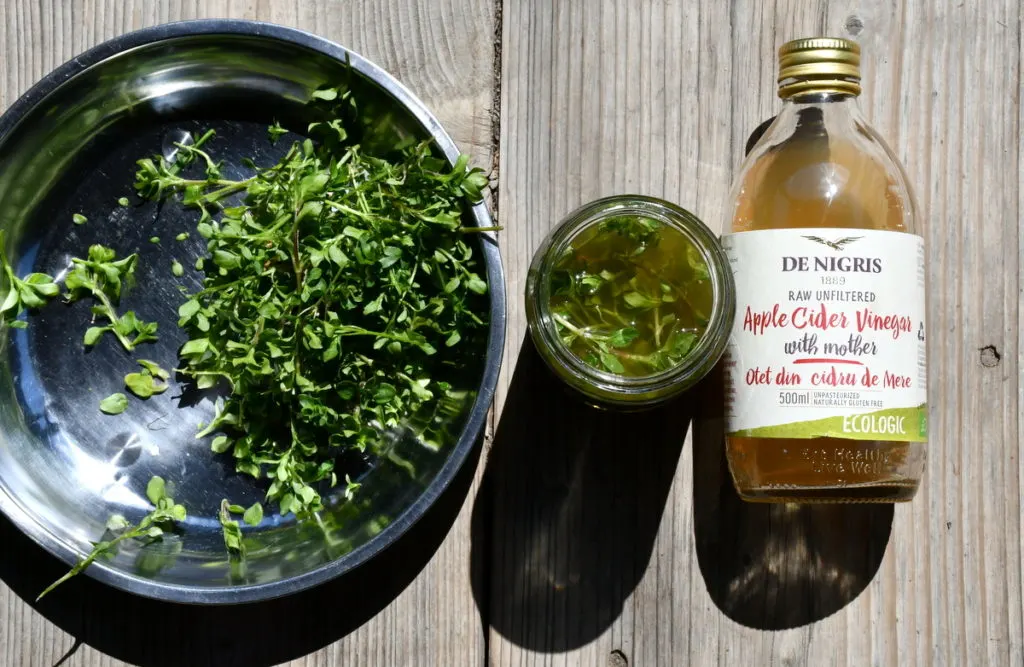
Add enough apple cider vinegar to cover them, then add molasses if using. Cover with a glass or plastic lid – or put a plastic bag under a metal lid as a barrier so as not to contaminate your batch.
Let it sit for 3-4 weeks, giving it a little shake each day you remember.
Strain and store for several months. If you have a fridge, then store it in there. Without a fridge, store it in your pantry or someplace dark.
You will go through it quicker than intended, it is hard to make too much of a good thing.
Chickweed Salve
If you have sensitive skin, you might want to give chickweed remedies a try.
Chickweed can heal anything from inflamed, hot and itchy skin, to cleaning wounds and soothing bug bites.
Ingredients you’ll need to make your own chickweed salve include:
- 2 large handfuls of fresh chickweed
- 1 1/4 cups olive oil
- 1 ounce beeswax
- 30-50 drops lavender essential oil (optional)
For the full instructions on how to make a healing chickweed salve, click over to Learning Herbs.
How to eat chickweed
Besides harvesting for medicinal uses, chickweed can also be eaten for the simple pleasure of introducing nutritious wild greens into your diet.
The more diversely you eat from the land, the more complex vitamins and minerals you receive. This, in turn, makes you very wealthy indeed. It is all a matter of how you look at life.
You needn’t eat weeds because you are poor.
Eat “weeds” because you are aware, enlightened and wise. With that knowledge, survival becomes thrival. Sit and think about that for a moment, then get ready to eat some chickweed and digest that information.
Eat your foraged chickweed fresh
Fresh chickweed is the absolute best.
Once you find a nice patch of chickweed, refrain from harvesting it all at once, for a little bit goes a long way. It is like having fresh cut-and-come-again lettuce in your garden. Harvest a handful at a time, leaving it to continue growing until the next picking.
Keep in mind that chickweed roots are sensitive…
So, cutting with scissors, or plucking each stem one-by-one is the best. Never go down to the ground, as they can be difficult to wash. If you stick to harvesting the tips, just give them a good shake to remove any hidden critters, then go ahead and munch on them out in the field.
If you’ve never sampled chickweed before, or are facing some trepidation in gaining courage and confidence in your foraging abilities, go ahead and search for foraging classes in your area. That way, you can meet up with other people who are as crazy about the idea of eating weeds as you are.
Also, if you are new to eating weeds in general, chickweed in particular, you may be wondering: what does chickweed taste like?
In short, chickweed tastes pleasant, green, grassy and healthy. It is also very neutral, proving that you can use it just about any which way.
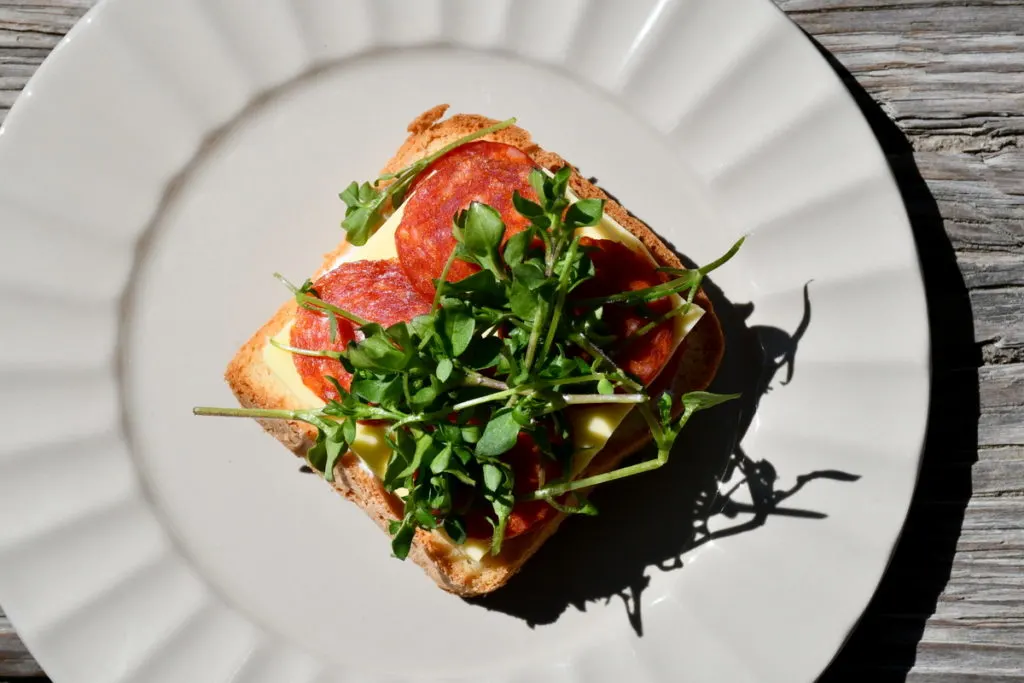
Add chickweed to your:
- salads
- stews
- stir fries
- toast
- sandwiches
You can use chickweed to garnish anything from scallops to a plate of prosciutto and cheese.
Chickweed pesto
If you have a large enough patch of chickweed to harvest 6 full cups packed with fresh stems all at once, then I can only assume that chickweed pesto is in your near future.
Here is a recipe you can forage for and make at home.
Dried and powdered chickweed
Drying chickweed is one method, besides infusing it in tinctures, vinegar, or oil, that comes in handy for practical reasons.
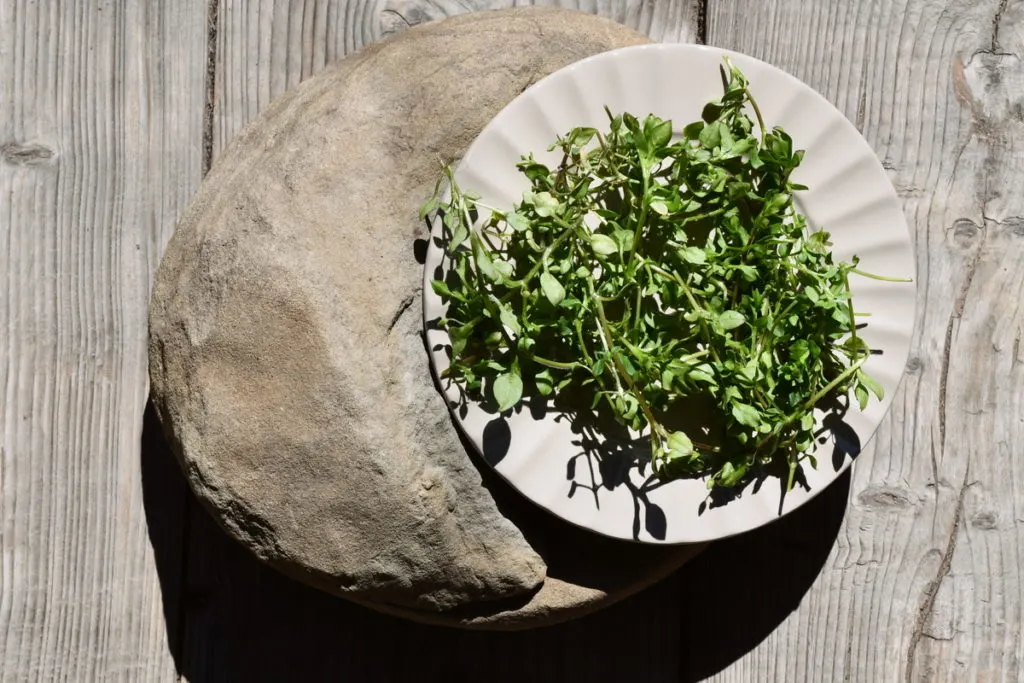
In summer, or winter, what is one to do who wishes to imbibe a healing chickweed infusion?
That’s right, you simply use the dried chickweed.
You can easily dry your herbs on a drying rack, or hang a bunch indoors in a dry, airy place. Of course, if you have a dehydrator, you can utilize that too. Chickweed will dehydrate quickly.
To take it one step further, you can even grind the dried herb into a powder. It may lose some of its beneficial nutrients, but it’s still worth the effort.
You can then combine your chickweed powder with nettle powder, garlic powder, onion powder and so on. Every little bit is good for the body.
Frozen chickweed
Another quick way to preserve chickweed is to freeze it for later. Remember that fresh is best, but this preservation method comes pretty close.
You can freeze it in bunches or chop it up into bite-sized pieces. Alternatively, you can toss it into your blender with a little bit of water. Pour it into an ice cube tray and call it a weed-ful and crafty harvest.
Once you learn to identify chickweed, you will start seeing it pop up everywhere.
Now, you have absolutely no good reason not to eat it.

Get the famous Rural Sprout newsletter delivered to your inbox.
Including Sunday ramblings from our editor, Tracey, as well as “What’s Up Wednesday” our roundup of what’s in season and new article updates and alerts.

